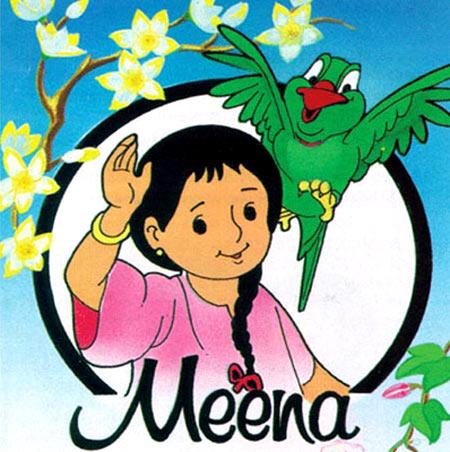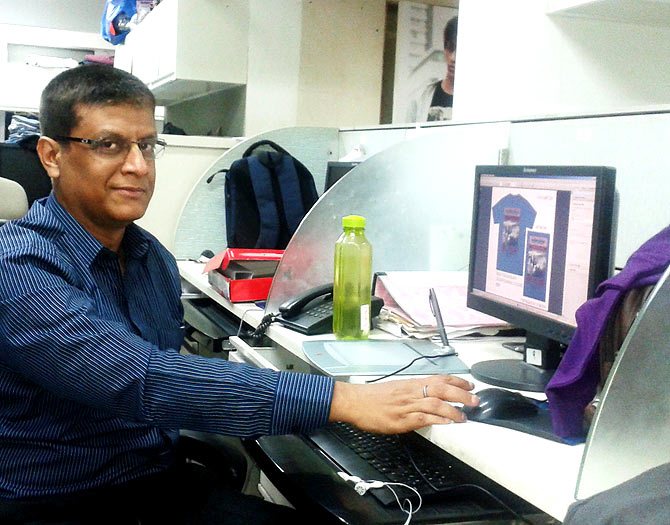 | « Back to article | Print this article |
What you must know to make it big in animation
We'd earlier reported about how a career in animation is not hot any more!
While a lot of young professionals shared the disadvantages of pursuing the career, some of them told us why it is important to be patient and resilient when jobs are less and times are tough.
Senior creative professional Sanjoy Ghosh is among those who have seen turbulent times in his brief animation career.
Currently working as senior graphic designer at Globus, Ghosh talks about making the right career choices, being patient during difficult times and knowing when to quit.
As part of our series on the animation industry in India, we've spoken to a young professional, a senior animator and several industry experts to give you, our readers a better perspective on its workings.
Sanjay Ghosh was 35 years old, when he'd left a stable advertising career and opted for a creative career in animation.
Despite being trained by the best of people in the industry -- he's trained under Ram Mohan, the godfather of Indian animation -- Ghosh had his fair share of struggles and turbulent moments.
Having survived a series of challenges, job trials and failed experiments, today, he’s working as senior graphic artiste at Globus and heads the design team besides training several young professionals under him at the organisation.
Read on interesting insights from the senior professional's career journey, the lessons he's learned from his own mistakes and his advice to future professionals...
Inspiration from Meena, India's first animation film
After finishing my graduation from JJ School of Arts in 1986, I started my career as a trainee in an advertising agency.
The industry was doing well around that time but after a few years, I began to lose interest.
I was a creative person and work in the agency was getting monotonous.
Around 1995, 2-D animation was just catching up in India.
Probably the only Indian animated film at that time was Meena which comprised a series of 13 episodes dealing with issues concerning the girl child in south Asia by released by UNICEF.
The animation for the film was done by Ram Mohan, who later on came to be known as the 'godfather of Indian animation'.
The film received wide critical acclaim and immediately, there were reports about how 2D animation was the next big thing.
The idea of animation drove me to sleeplessness.
I had always wanted to pursue a creative career, and after having spent about ten years in advertising, I was desperately looking for a change.
This was the time when Ram Mohan and Ronnie Screwvala had started an animation studio in Mumbai called UTV Toons.
Screwvala had big plans when he started the company.
He had hired professional animators from Philippines to train the workforce in India.
They’d carefully handpicked artists who would be trained under Ram Mohan and these international animators. I was selected for the drill too.
It was a privilege to be trained directly under Mohan because all of us were in awe of him. From him, I learned to draw sketches for animation, and related techniques.
After the training, I was appointed as a junior animator at UTV Toons.
My age? I was 35 and my second career had just begun.
Second career, first job: Facing the challenges
My team comprised people who were as young as 15 and 18 and it was challenging to match their speed and ideas.
It wasn't a permanent job.
We were hired on contract for 18 months on the condition that if we were to leave the studio before the contract expired, we'd have to pay a compensation of Rs 54,000 as penalty to the company.
At that point, we were all too passionate about launching our respective animation careers to mind that clause in the contract.
I was enjoying every bit about this new career, because I loved animation and there was so much for me to learn in it.
I had never used a computer before, so I had to teach myself how to use it before I could work on it.
Within a year, the studio had attracted a lot of attention and we received an exciting project offer from Funbag Animation Studios Canada.
Funbag had wanted to turn the famous cartoon strip For Better or For Worse into a film.
Unfortunately, around this time Screwvala decided to send the animation professionals back to their country.
He reasoned it by saying: We have already spent a lot of time training our Indian team and now we are ready to launch them into this project.
It was a very bold decision on his part but the outcome was negative.
Frankly, we were not ready for the project and after spending more than a year, which obviously delayed the launch, the film did not get the response it expected.
The quality of animation in the film left much to be desired and it was not even close to the international standards.
Back home in India, the film’s delay had burned a hole in the company’s pocket.
Since the film was not received well internationally, our studio suffered. We were not getting too many international projects.
By now, the company had grown into a full-fledged studio and had more than 150 employees under its roll.
We had so many animators, clean up artists and in-between artists. When the company stopped getting projects, our salaries were delayed. Some of us did not receive our salaries for six months.
We were asked to stay at home and said that we’d be called if and when there would be work.
Although it seemed convenient for most of them who were single and had recently entered the industry, it did not help people like me who had a family to feed.
I was living with my wife and a 10-year-old son.
I was never asked to leave but I knew staying back would be futile.
Some of my friends quit and joined Crest Animation, Toonz Animation and other leading animation studios.
Some of them relocated, and some others moved away from animation -- they choose advertising, page-making, photography etc.
When it was my turn to make that choice, I thought really hard.
There was no way I was going back to advertising, but I wasn’t sure if I could afford to survive the challenges and uncertainty of jobs in animation. I was answerable to my family.
I started searching for jobs in other animation companies and was lucky to find one quick enough.
The remuneration wasn't great, so I requested my wife to take up a part-time job and help me support the family.
Please click NEXT to continue reading....
'If you are in a creative career, the day you stop learning, you stop growing'
Quitting animation, joining Globus
I joined 4000 Incorporated as a graphic illustrator; this firm was a subsidiary of a US-based company.
Since the US-based companies are not allowed to outsource work outside of the country, we were hired under the name of this Indian company 4000 whereas we were asked to work on US-based projects.
This time economic recession hit us and the US-based company was finding it difficult to pay us monthly salaries.
Once again, I began searching for jobs. One such application landed me an interview at Globus.
They liked my work and appointed me as a senior graphic artist. Since then, there has been no looking back for me.
At Globus, I design the graphics for women and men's tee-shirts.
In the last few years, through numerous trial and errors, I can say I have learned quite a bit about printing techniques, and fashion technology here at Globus.
I love taking risks and welcome all kinds of suggestions and criticisms about my work.
If you are in a creative career, the day you stop learning and adapting, you stop growing.
Despite the experience, when I try my hand at something new, sometimes I fail, but I take it as part of my learning.
At this point, I must mention that my learnings from animation has definitely helped me understand and interpret designs that work.
I have learned that perseverance and patience is all that counts.
Today, I am doing pretty well at my job.
Do I regret quitting the animation industry? Yes, at times, I do.
When I look at my peers who could afford to hold their ground and stay put in the animation industry, I wish I could have done that. It's a temporary feeling.
If I were to look at the brighter side of things, I am happy I chose to continue in a creative career.
'Young animators have ego issues; learn to explore your talent beyond the realms of technology'
Career advice for future professionals
Would I recommend animation as a career? Yes, definitely.
I've always felt that the animation industry is booming and that a career in it is lucrative, but there is also a price that you have to pay for it.
You have to survive struggle a lot and you have to be in a position where you can afford to take that career risk -- to work without being paid and to work for lower salaries.
About the young animators, I feel most of them have ego issues, which needs to be taken care of.
When you are new to the industry and a fresher with no work experience, you should ideally ignore the ‘remuneration part’. I’d say, don’t even think about what salary you will get in the first two-three years of your career.
Animation is one industry where you learn more stuff on the job than you do in the four walls of your classroom.
My advice to young animators and aspiring creative professionals is to look at the initial few years as your training ground.
Invest that time in learning as much as you can and building your skills.
I agree that technology is a great life saver. It has reduced the cost of labour and saves precious time.
But consider this example: I can be an artist using the most updated software called Illustrator version 6 and will still not be able to recreate an image done by another artist in Illustrator version 2.
Why? Because no matter how updated my technical skills are, I may fail at understanding and executing the task.
Similarly, when you are studying at an institute, your instructor will teach you a 1000 ways to draw a human figure...running, dancing, walking etc. But when you work on a project, you must know how to draw a picture that satisfies the brief given to you.
The direction of action, hand movements and facial expressions -- everything has to be perfect. Technology too has limitations too; you should learn to explore your talent beyond the realms of technology.
At the end of the day, every industry will suffer setbacks at some point in time.
It is a classic case of survival of the fittest. If you are good enough and have the skills the industry is looking for, it won’t take you long to find the right job.
The handful of people who are running the biggest animation houses in India are best at their jobs. They should inspire you.
Also, there are very few countries in the world that promise so much scope in animation. And India is one of them.
There are artists in China, Japan, Korea, Philippines, Bangladesh and Pakistan as well, but the biggest advantage we Indians have is that we can communicate in English, which naturally attracts international production houses.
So, worry not, the future is definitely bright for those who have the skill, talent and courage to see through these minor setbacks.
(As told to Divya Nair)


